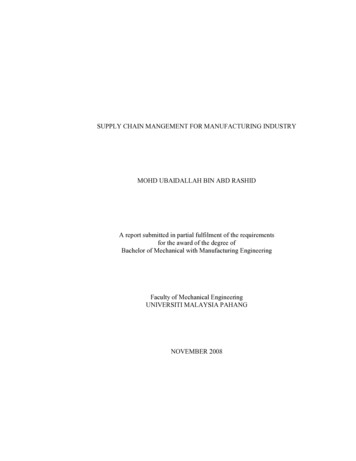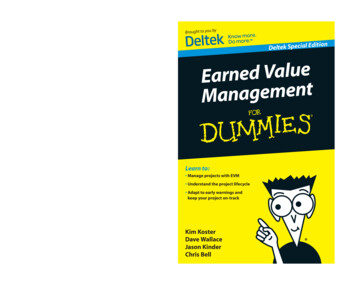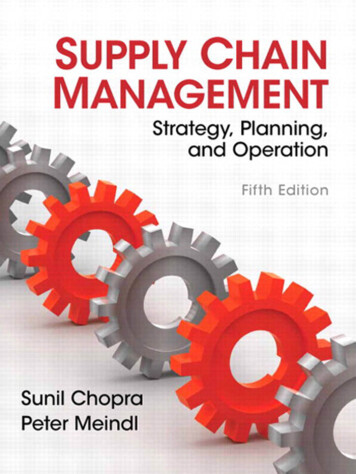
Transcription
iSUPPLY CHAIN MANGEMENT FOR MANUFACTURING INDUSTRYMOHD UBAIDALLAH BIN ABD RASHIDA report submitted in partial fulfilment of the requirementsfor the award of the degree ofBachelor of Mechanical with Manufacturing EngineeringFaculty of Mechanical EngineeringUNIVERSITI MALAYSIA PAHANGNOVEMBER 2008
vABSTRACTThis thesis discusses one of the topics in engineering management which isSupply Chain Management. Engineering Management is a term that is used todescribe a specialized form of management that is required to successfully leadengineering personnel and projects. The term can be used to describe eitherfunctional management or project management- leading technical professionals whoare working in the fields of product development, manufacturing, construction,design engineering, industrial engineering, technology, production, or any other fieldthat employs personnel who perform an engineering function.Supply Chain Management is the management of a network of interconnectedbusinesses involved in the ultimate provision of product and service packagesrequired by end customers. Supply Chain Management spans all movement andstorage of raw materials, work-in-process inventory, and finished goods from pointof-origin to point-of-consumption.Practicing supply chain management in industry giving benefits to companyin term of utilizing man, machine, method and materials. The outcomes of this thesisshow the practical of the theory. Analysis using Time Study method that founds byFederick W Taylor show the importance of applying engineering management inindustry.Result that obtain in this thesis show that increasing supply from 12 cars to 14cars can done.
viABSTRAKTesis ini membincangkan satu topik dalam bidang kejuruteraan pengurusaniaitu Pengurusan Rantaian Perbekalan. Kejuruteraan pengurusan adalah istilah yangdiguna untuk mendefinasikan pengurusan yang pakar yang diperlukan untukmenjayakan individu dan projek dalam kejuruteraan. Istilah ini juga boleh digunakanuntuk mendefinasikan kefungsian pengurusan atau pengurusan projek- menjadirujukan pakar teknikal yang bekerja di dalam bidang pembangunan produk,pembuatan, pembinaan, kejuruteraan rekaan, kejuruteraan industri, teknologi,pengeluaran atau bidang bidang lain yang mengupah pekerja untuk menjalankanfungsi kejuruteraan.Pengurusan Rantaian Perbekalan adalah pengurusan hubungan yang berkaitdalam perniagaan yang diceburi yang melibatkan ketetapan produk dan perkhidmatanpaling terbaik yang dikehendaki oleh pengguna akhir. Pengurusan RantaianPerbekalan merekod semua pergerakan and penyimpanan bahan mentah, proseskerja, inventori dan produk akhir daripada titik permulaan hingga titik akhir sesuatuproduk.Penggunaan Pengurusan Rantaian Perbekalan dalam industri memberikebaikan kepada syarikat dalam aspek pemanfaatan pekerja, mesin, metode danbahan. Hasil tesis ini telah menunjukkan pengaplikasian teori secara praktikal diindustri. Analisis tesis ini yang menggunakan cara Pengkajian Masa yang dihasilkanoleh Federick W Taylor menunjukkan kepentingan mempraktikkan kejuruteraanpengurusan dalam industri.Keputusan yang didapati dalam tesis ini menunjukkan penghantaran bolehditingkatkan dari 12 buah kereta ke 14 buah kereta.
viiTABLE OF CONTENTSPageSUPERVISOR’S DECLARATIONiiSTUDENT’S TABLE OF CONTENTSviiLIST OF TABLESxLIST OF FIGURESxLIST OF ABBREVIATIONSxiLIST OF APPENDICESxiiCHAPTER 1INTRODUCTION1.1General Overview11.2Project Background21.3Objective41.4Scopes of the Project.41.5Problem Statement51.6Outline51.7Gantt Chart6CHAPTER 2LITERATURE REVIEW2.1Introduction72.2Supply Chain Management72.1.18Decision Variable in SCM
viii2.1.22.1.3Just in TimeJust in Time and Lean Manufacturing2.1.4Seven waste of JIT system102.1.5Elements of JIT112.1.6JIT Implementation162.1.4JIT Implementation Chalenges162.1.8Addresing Concerns182.2Supply Chain Structure2.3Benefits of SCMCHAPTER 38919METHODOLOGY3.1Purpose203.2Flow chart of methodology203.2.1 Flow chart223.3Activities of methodology233.4Literature review243.5Plant visit243.6C-Class Mercedes Benz Assemble Process263.7Logistic Building Layout263.8Area of study283.9Equipment used283.10Analysis293.11Discussion and conclusion293.12Report writing29CHAPTER 4RESULTS AND DISCUSSION4.1Introduction304.2Time Study Calculation304.3Conclusion40
ixCHAPTER 5CONCLUSION AND EFERENCES44
xLIST OF TABLESTable No.Page1.1Process Flow and Person In Charge of Unpacking Trim31.2Process Flow and Person In Charge of Body Parts43.1Flow chart of the project223.2Methodology of the project274.1Performance rating factor for each individual364.2Normal time of each process364.3Plant work time, operation time and allowance time384.4Type of car and the production in a day384.5C Class work time, operation time and allowance time39LIST OF FIGURESFigure No.2.1JIT avoided activities3.1Plant layouts and the supply chain between departments in AMMPage11that produces C Class Mercedes Benz car253.2Logistic Layout and area of study274.1Storage area314.2CKD move using forklift from storage to working area324.3Unpack CKD Process324.4Racking process334.5Baby truck used to move rack from Logistic to Production Line334.6Arrived at Production Line34
xiLIST OF ABRREVIATIONSSCMSupply Chain ManagementMBMMercedes Benz MalaysiaAMMAutomotove Manufacturer MalaysiaMBPSMercedes Benz Production SystemJITJust in TimeEDIElectronic Data InterchangeVMIVendor Management InventoryECREfficient Consumer ResponseTPSToyota Production SystemSMEDSingle Minute Exchange DieTPMTotal Productive MaintananceSWOTStrentgh, weakness, oppurtunities and threatsLBLogistic BuildingBSBody ShopPSPaint Shop
xiiLIST OF APPENDICESAPPENDIXTITLEPAGEA1Gantt Chart of FYP 145A2Gantt Chart of FYP 246A3Skills chart of AMM employee47
1CHAPTER 1INTRODUCTION1.1General OverviewSupply Chain Management (SCM) is a system that used by an organization toorganize the process of planning, implementing and controlling the operations of supplychain as efficiently as possible. Supply chain management spans all movements andstorage raw materials, work-in-process inventory and finished goods from point-oforigin to point-of-consumption (Jay Heizer and Barry Render,1996).Nowadays, SCM applied in various industries such as automotive, manufacturingand services. SCM give various benefits to an organization that apply the systemespecially in term of optimizing time and space. More than that, SCM will keep the flowof process run smoothly. In order to reduce the number of defective parts, cut labor costsand improve efficiency, SCM is the tool that will be used.Normally, SCM will achieve one of the goals which are adding value chain.Value chain means the function within a company that add value to the products orservice that the organization sells to customer and for which it receives payment (HenriPierreval, Roman Bruniaux and Cristopher Caux, 2006).
21.2Project BackgroundSupply Chain Management is an important system that needs to apply inindustry. In order to practice the knowledge practically, case study need to be done to lettheory can be applied. Nowadays, many companies collaborated through a network ofproduction units, so as to provide customer with the desired products. SCM, which aremore precisely addressed in this thesis generally refer to a set of networkedorganizations working together to source, produce and distribute products and service tothe customer.Automotive Manufacturing Industry is an industry that really applies SCM toperform a good automotive. Several manufacturers integrate successfully their internalprocess to external suppliers and customers in a single supply chain (Frolich andWestbrook, 2001).Technology and management need to work together to achieve good result.Mercedes Benz is an establish company that produce an automotives. In order toassemble Mercedes Benz automotive in Malaysia, Mercedes Benz Malaysia (MBM),was collaborate with Automotive Manufacturer Malaysia (AMM).This collaboration applied SCM for the purpose of producing automotive to themaximum efficiency. There are several departments in a plant. Each department doestheir own job to achieve one objective which is produce good automotives. Eachdepartment need to contact efficiently and will use SCM as the contact medium. Goodcontact between departments in a good manner will let the plant work smoothly.Logistic Department in AMM is an organization that responsible to managereceiving raw material, storage and do delivery in the manner that ask by twodepartments which is Body Shop and Production Line.Body Shop is the department that responsible to assemble each part of car bodypart to become a complete car framework. Production Line is the organization that doesthe job to produce complete car. Their responsible is to receive car framework from
3Body Shop and trim part from Logistic Department. After Production Line finish theirjob, then, a complete car ready to send to market to sell.The flow of process and person In charge of Logistic Department thatresponsible of unpacking trim section and body section of Mercedes Benz Automotiveparts is as in Table 1.1 and Table 1.2:Table 1.1: Process Flow and Person in Charge of Unpacking TrimDepartmentSectionType of DocumentLogisticUnpacking TrimProcess FlowPerson in ChargeOperator and Forklift DriverForklift DriverOperatorOutlineReceivingArrange at UnpackingChecking, Sorting, GroupingOperatorRackingOperatorSupply to Trim Department
4Table 1.2: Process Flow and Person in Charge of Body PartsDepartmentSectionType of DocumentLogisticBodyProcess FlowPerson in ChargeOperator and Forklift DriverForklift DriverOperatorForklift Driver1.3OutlineReceivingArrange at UnpackingStorageSupply to Body ShopObjectiveThe main objective of this thesis is to study the system that used by the plant,analysis and find capacity of the system and propose suggestion of supply chain betweenLogistic Department and Production Line of trim part of C-Class Mercedes Benz Car1.4Scopes of the ProjectThis plant have connection problem between Logistic Department andProduction Line on rack part that consist trim part, this study will work on scope to solvethe problem. This scope consists of:i.Record the time to move Complete Knocked Down (CKD) from storage area toworking area.
5ii.Record Time to unpack the CKD, move and arrange it on rack.iii.Record time to move all the parts from Logistic to Production Line.iv.Find the capacity of sending trim part of C Class Mercedes Benz Car fromLogistic to Production Line and propose suggestion to improve the supply chain.1.5Problem StatementIn order to fulfill the demand that asks by Production Line, analysis the strengthof Logistic need to be done. However, this data do not available yet. Because of that, theproblem occurs:i.Logistic Department can’t guarantee to supply the demand that ask byProduction Line if the demand is increasing suddenly in any number.ii.Logistic Department does not has its capability data on supply trim part toProduction Line.iii.Logistic Department have problem to identify the correct number of man andmachine need by that department so that the method applied are not known theefficiency.1.6OutlineChapter 1 is the introduction of the project. This chapter also explains theobjectives and scopes of the project.Chapter 2 is discussion about the literature review. This literature review willelaborate on SCM and the process that operate in plan. This chapter based on study fromAMM Plant, text books, journal and sources from internet.
6Chapter 3 explains the project methodology for Supply Chain Management oftrim part of C-Class Mercedes Benz car. This chapter also shows how to find andanalysis the parameter that will be investigated to answer the objectives of this project.1.7 Gantt ChartThe Gantt chart of this project is done to make sure that the process ofcompleting this project will follow the schedule that be planning earlier. Based onschedule, the process of this project will doing in smooth condition. Besides that, thisschedule can guide and show what a progress is going on by the time. The Gantt chart ofthis project is referring in the Appendix A1 and A2.
7CHAPTER 2LITERATURE REVIEW2.1IntroductionThe purpose of chapter 2 is to explain about principles and function of SCM.Since AMM is an automotive manufacturer vendor for Mercedes Benz Malaysia, thisplant implements a system that called Mercedes Benz Production System (MBPS).MBPS is a system that implements Just in Time (JIT). JIT is a concept thatreally focused on utilizing SCM. This chapter will explain about JIT and how thisconcept gives big benefits to SCM.To let we understand better on this plan activities that use MBPS, that it good forus to review on JIT and it’s contain.2.2Supply Chain ManagementSCM is a network management that includes vendors of raw materials, plantsthat transform those materials into useful products, and distribution centers to get thoseproducts to customers (Lawrence D. Fredendall Ed Hill,. 2000).
8Automotive industrial groups are introducing structural changes in theirmanufacturing systems in order to guarantee optimal trade-off between customersatisfaction and production costs (Haag and Vroom, 1996; Proff, 2000)Without any specific effort to coordinate the overall supply chain system, eachorganization in the network has its own agenda and operates independently from theothers. However, unmanaged network results inefficiencies. For example, a plant mayhave the goal of maximizing throughput in order to lower unit costs. If the end demandseen by the distribution system does not consume this throughput, there will be anaccumulation of inventory. Clearly, there is much to be gained by managing the supplychain network to improve its performance and efficiency.2.1.1 Decision Variables in SCMIn managing the supply chain, the following are decision variables: Location- of facilities and sourcing points. Production- what to produce in which facilities. Inventory- how much to order, when to order, safety stock. Transportation- mode of transport, shipment size, routing and scheduling2.1.2 Just in TimeThe development of JIT in Japan was influenced by a crowded country with fewnatural resources. Japanese became very sensitive to waste and inefficiency. They regardscrap and rework as waste and excess inventory as an evil because it takes up space andties up resources. A president of Toyota (Eiji Toyoda) gave a mandate to his people toeliminate waste. JIT approach was developed at the Toyota Motor Company of Japan by
9Taiichi Ohno (which became Toyota vice president). JIT is a term to describe ToyotaProduction System (TPS), widely recognized as one of the most efficient manufacturingoperations in the world. JIT requires only necessary units be provided in necessaryquantities at necessary times. Items are supplied only when needed or “just-in-time”. Itcan be an effective method for reducing inventory and stock-outs (Henri Pierreval,Roman Bruniaux and Cristopher Caux, available online 6 December 2006).Some firms have successfully improved their supply chain performance byimplementing an approach known as Just in Time (JIT). As known, the main goal of JITconsists in establishing optimal combination of competition and cooperation consideredas a basic feature of inter-firm networks (Pfohl and Buse, 2000).With JIT, the vendor specifies delivery quantities sent to customers through thedistribution channel using data obtained from Electronic Data Interchange (EDI). JIT,Vendor Management Inventory (VMI) and Efficient Consumer Response (ECR) all referto similar concepts, but applied to different industries. For example, the grocery andapparel industries tend to use ECR, whereas the automobile industry tends to use VMIand JIT.2.1.3Just In Time and Lean ManufacturingJIT emphasizes continuous improvement to eliminate waste. Toyota ProductionSystem (TPS) emphasizes employee learning and empowerment in an assembly lineenvironment. Lean Production is a term used to describe JIT and Toyota ProductionSystem (TPS). AMM used Mercedes Benz Production System (MPS) in order to applyJIT in the plant. MPS and TPS is a tools that quite similar in order to apply JIT in plant.JIT is a philosophy of continuous and forced problem solving that supports leanproduction. Lean production supplies the customer with their exact wants when thecustomer wants it without waste through continuous improvement.
102.1.4Seven waste of JIT systemWhen applying JIT, there is waste that plant need to focus. In the JIT philosophy,wastes include anything that does not add value to the product. The wastes are: Overproduction. Queues. Transportation. Inventory. Motion. Over-processing. Defective product
11Figure 2.1: JIT avoided activities2.1.5 Elements of JITSupplier networks.oSupplier and purchaser work together to remove waste and drive downcostsoFew suppliers
12Nearby supplierso oRepeat business with same suppliersoSupport suppliers so they become or remain price competitiveoShare forecasts of demandoFrequent deliveries of small-lot quantitiesoLong-term contractoMinimal paperwork to release orderPull production system.oA pull system uses signals to request production and delivery fromupstream stationsoUpstream stations only produce when signaledoBy pulling material in small lots, inventory cushions are removed,exposing problems and emphasizing continual improvementoPush systems dump orders on the downstream stations regardless of theneed Cellular layout.oCell produce similar items, setup time requirements are low and lot sizescan be reducedoBuild work cells for families of productsoInclude a large number operations in a small areaoMinimize distanceoDesign little space for inventory
13 oImprove employee communicationoUse poka-yoke devicesoBuild flexible or movable equipmentoCross train workers to add flexibilitySmall lot production (reduce inventory).oSmall lot production requires less space and capital investment,transportation between station can be simplified and quality problems areeasier to detect.oThe inventory level is like the level of water. It hides problems but allowsfor smooth sailing. When the inventory level is reduced, the problems(rocks) are exposed. Quick setup.oShigeo Shingo – study die set up systematically to reduce changeovertimes.oReduced set up time on a 1000 ton press from 6 hours to 3 minutes usinga system called SMED (single minute exchange of dies) Kanban production control system.oKanban – Japanese word for cardoThe card is the authorization for the next container of material to beproducedoContains basic information such as part number, brief description, type ofcontainer, quantity per container, preceding station and subsequentstation
14oKanban is corresponds to a standard quantity of production or size ofcontaineroThe number of Kanban card or container, in a JIT sets the amount ofauthorized inventory.oTo determine the number of containers moving back and forth betweenthe using and producing area, need to set the size of each container. oNeed to know the lead time needed to produce a container of partsoNeed to know the amount of safety stock neededTotal productive maintenance (TPM)oMachine cannot operate continuously without some attentionoMaintenance activities can be performed when the machine breakdown torestore the machine to its original operating condition.oBreakdown maintenance involves the repairs needed to make a failedmachine operationaloPreventive maintenance is a system of periodic inspection andmaintenance designed to keep a machine in operationoWith accurate records on the time between breakdowns, the frequency ofbreakdowns, and the cost of breakdown, we can mathematicallydetermine the best preventive maintenance schedule.oBreakdowns can still occur, even with this degree of precision.oJIT requires more than preventive maintenance. JIT requires TotalProductive
A1 Gantt Chart of FYP 1 45 A2 Gantt Chart of FYP 2 46 A3 Skills chart of AMM employee 47. 1 CHAPTER 1 INTRODUCTION 1.1 General Overview Supply Chain Management (SCM) is a system that used











